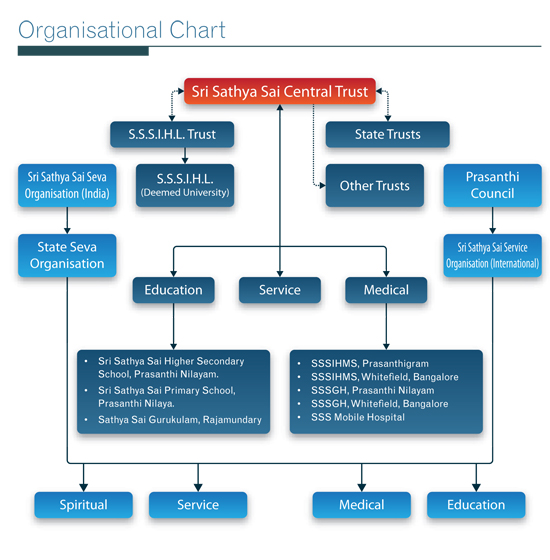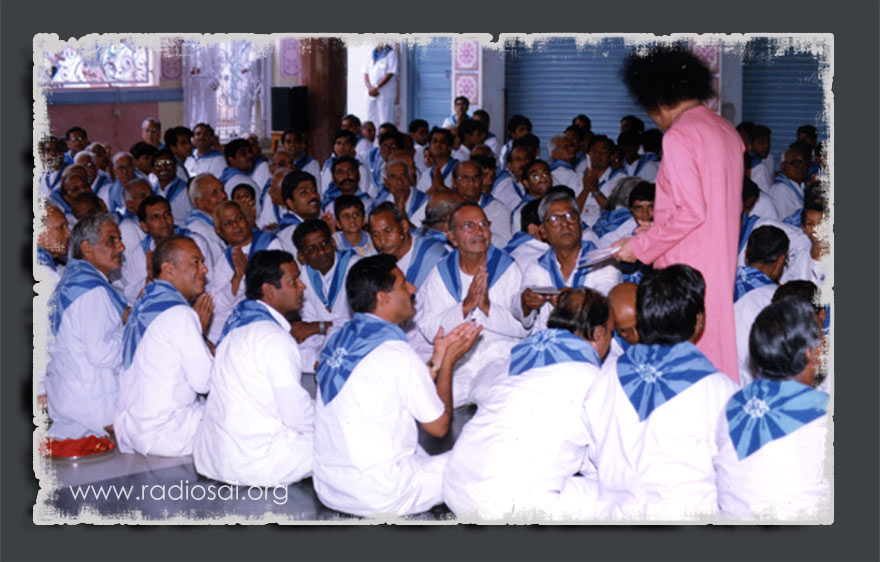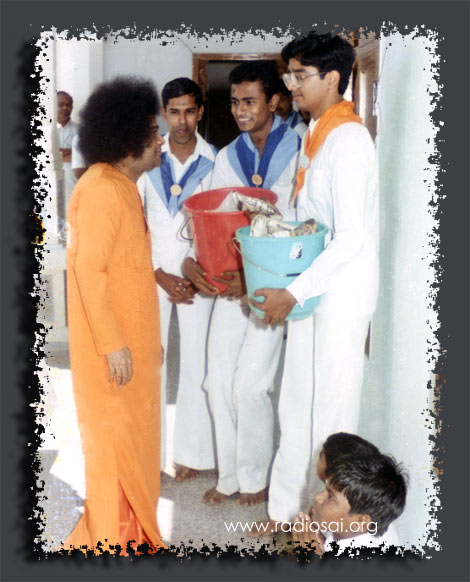|
|
| 'Like' us on Facebook | Follow us: |
Posted on: Feb 19, 2013
A Life of Servitude
- an exclusive conversation with Mr. K. Chakravarthi
PART 2
Organisational Verticals Founded by the Avatar
KM: How do these verticals intersect, namely, the Sri Sathya Sai Seva Organisation, the Sri Sathya Sai State Trusts and the Sri Sathya Sai Central Trust?
 |
K. Chakravarthi: There are two ways of looking at it. Bhagawan had made it clear that the organisation He blessed to use His name ‘Sri Sathya Sai’ was more for the sake of devotees getting together and engaging themselves in service, not for the sake of Bhagawan but for the sake of their self-fulfillment. After all, what's the purpose of doing service? It is not for Swami's sake. Serving selflessly in a community could be in the form of value education, a non-formal setup like Bal Vikas, it could be by way of bhajan mandals where people could congregate and then sing the glory of God, or organize medical camps or veterinary camps in order to provide some relief to the people in those areas.
All these things are not meant merely to provide emotional and physical relief to people, but also to really refine one's self and also promote a sense of selflessness in human beings so that you not only care for yourself and your immediate family, but you're expanding yourself by thinking about others, by doing work for others. So, this enlarges the devotee's vision of what one is meant to be.
Swami made it clear that whether it is at a district level or state level, these activities have got to be done from the point of view of giving cohesion to the setup. You have a district level, there are a set of devotees who get together and organize. Similarly at the state level, and then all the states put together create the All-India Organisation and similarly Organisations in different countries are set up, but they are all meant to be for the sake of doing not only social service but also for promoting one's own spirituality.
 |
|
Source: Annual Report of the SSSCT (2011-12) |
Here is an Organisation which is a spiritual Organisation but from Swami's point of view, spirituality is best attained through service. Therefore it's a spiritual Organisation, it's a service Organisation, and the basis of it is spirituality. The expression of it is service.
KM: How do the Sri Sathya Sai Seva Organisation of India, for instance, and the Sri Sathya Sai Central Trust connect?
K. Chakravarthi: The Central Trust is a body which is governed by the laws of the land, especially Income Tax Act, and the Religious and Endowments Trust Act. These are the laws which govern the setting up and the functioning of the Trusts in the country and the state. So, the Central Trust has to apply for Income Tax exemption for donations received; the people who give money as donors have to get eligibility to deduct their income for tax purposes; that means you have to get an exemption from the Income Tax Commissioner.
Similarly, if you were to carry on work as a charitable trust in the state of Andhra Pradesh, for instance, there is an A. P. State Religious and Endowments Trust Act. So, all the activities have to conform to these provisions and whatever reports were to be submitted periodically to the Government in the Centre or even the state, that we complied with.
Now, for instance, another Act which is the Foreign Currency Regulations... not only our Central Trust but many, many Trusts in the country receive donations from abroad, and they are supposed to be regulated by the Foreign Contribution Regulation Act. We have to send our returns to the Government of India. So these are things which are to be done in a legal way, accounted for and complied with.
The Sri Sathya Sai Seva Organisation is a congregation of devotees. And they have their local service activities, and then in order to facilitate some of these activities, there are also the State Trusts.
Now, the State Trusts, much like the Central Trust also apply for exemption from the governments concerned and carry on their activities in the manner in which they ought to be done. If any activities at the State level are to be done, then it is possible that those who are organising the various functions such as medical camps - they give a budget that this is what is required to be done. And if the State Trust is in a position to extend that assistance; they do so. There should not be a collection of funds in an unaccountable way.
So, it should be systematically done, it should be transparent and no activities are done by way of a local collection which is likely to really harm the reputation of an organisation which bears the name of Sathya Sai.
Seva Dal: The Lifeline of the Sai Mission in India
The organisation has its relevance. Now for instance, you look at the volunteers, after all it maybe the biggest spiritual voluntary organisation in the country.
Seva Dal plays a very major role in maintenance of the Hospitals, especially Super Speciality Hospitals - both men and women volunteers take a lot of responsibility in keeping the whole place clean and tidy. They do so in General Hospitals and in the Ashram.
KM: And the museum, the canteens and the schools.
 |
| The Seva Dal are the very backbone of the Sri Sathya Sai Seva Organisation |
K. Chakravarthi: Everywhere, all institutions – schools, colleges, general security, and then they are at the service of the large number of devotees who come. We don't use the word crowd here; we use the word congregation because it's a congregation, it's not a crowd. These are all people who come out of love and reverence for Swami. They need some assistance here and there whether it's a question of being seated or going into a canteen for food or perhaps buying books. Any activity within the ashram also has to be sort of regulated in a way in which people find it easy to get things done.
 |
|
| Sai Seva Dal, ever ready to serve in the name of Sai |
And these Seva Dal volunteers manage during major activities like 23rd November Birthday Celebrations. When Swami was there, the congregation of people who came were not counted because you just don't count people, the heads, etc., but you see a vast sea of faces and those people have to be taken care of whether it is a water distribution in the Hill View Stadium… Every activity which you can think of is all done by these Seva Dal volunteers who are the heart of the Sri Sathya Sai Seva Organisation.
They come from different parts of the country and if you look at the national integration element of this, it's a very revealing thing because people from different parts of the country, from different states come on a rotation basis. I do not know whether there is a similar organisation in the country in which people from different parts of the country come and render such voluntary service. And what is it that they gain? They spend the money but the type of satisfaction they get by rendering this service according to them must be far more than the monetary value of the trip because by coming and going back, they would have spent some money. But I think it is more than compensated.
KM: And used up their holiday time, family time.
K. Chakravarthi: But it is not merely considered as a vacation; it is considered as a seva; it is something which uplifts them.
It's not merely question of coming and going. It's a question of participating in a set up in which the higher instincts of men are touched by the very presence of Swami.
KM: And as a daughter of two life-long Seva Dals, I can say Seva Dals look forward to coming to Puttaparthi as a great spiritual blessing.
K. Chakravarthi: It is. That's what Swami used to say; visiting this place itself is a source of strength... used to use the language of recharging one's battery. But the idea is that you come here once a year at least and feel uplifted, ennobled; you are part of something, a wider whole and it invests the person's life with a very special meaning and significance. It's not to be measured by ordinary things with which we normally measure our activities in the normal world.
Demystifying the Central Trust, its Functioning and Priorities
KM: Very true. Let's talk about the Trust once again. Now that the mainstream media attention has reduced, there are some questions that still linger in the minds of our devotees. For instance, since the Mahasamadhi, what steps has the Trust taken to reengineer itself for preserving, nurturing and expanding the legacy of Bhagawan Baba?
K. Chakravarthi: The Sri Sathya Sai Central Trust does not require reengineering; it just...
KM: But it had a sole Trustee till almost the Mahasamadhi.
K. Chakravarthi: Yes but the year before, Trustees were inducted by Swami Himself. Swami had been not merely a Founder Trustee but He was a sole Trustee for a long time.
KM: And the major decision maker, one would guess.
 |
 |
 |
 |
 |
 |
 |
 |
| Reporting to the Divine Boss - paying rapt attention to Divine instructions | |||||||
K. Chakravarthi: Yes, He was... I would say that all decisions were made by the Founder Trustee; He was also a sole Trustee. If the Sri Sathya Sai Central Trust has to do something after Swami's Mahasamadhi, it is the human beings who have been appointed as Trustees who have to get together and take some decisions on the basis of their best judgements.
When Swami was in the body, it is not as though the people involved gave up their judgement, but then they knew that the supreme judgement was vested in Him and therefore it was not necessary for people to take a position and then see whether this will meet with the approval of others and then come to a consensus and then do these things.
Anything that had to be done, you'd go to Swami and say, “Swami, this is the thing that needs to be done” and He asked you certain questions, you replied and He gave the decision; you carried it out; whether it's small or big it makes no difference. But when people in the physical absence of Swami have to take a decision, then there is no one single person who takes a decision.
So, the people who would have worked with Swami in various capacities, meeting in His presence know how Swami gives instructions. But, they are now put in a position where they have to look at these issues before them – whether it's a question of Hospital administration or giving assistance to the University or take some decisions regarding the activities in the Ashram, whatever it is. But there is a need for people to get together, discuss and then arrive at a conclusion and then take steps to implement them.
KM: What is a typical Trust meeting like? Do you all pray before you start?
K. Chakravarthi: Yes, this is ingrained in all of us; nothing here is begun without invoking the blessings of Swami. So, like it used to happen even when Swami was there, any official meeting which we used to conduct also started with Aumkaram. So, this tradition is very much in us and we carry it out.
KM: And you are 9 of you, I remember the media was dubbing you as the 9 planets, the 9 Ratnas, the 9 gems. Now, are the 9 gems united in their vision?
 |
|
Source: Annual Report of the SSSCT (2011-12) |
K. Chakravarthi:Basically, I would say that there can be no difference in terms of perspectives because it is a Sai perspective ultimately. But in terms of emphasis, in terms of the nitty-gritty details, now each one perhaps brings their experience, their judgment, their wisdom, their own perception. And what normally emerges at the end of it is a consensus and we say “Yes, this could be done, we will do that.”
So, we do not go by a majority/minority view because that polarises issues. What we normally do is that when some differences in perspectives are there, then we go through these things again and again, more by way of clarifying in one's own mind, by listening to a lot of people around you and then say that this seems to be the preferred way of doing things and therefore there is a consensus that emerges – not out of a formal mechanical way of building consensus but a way of spontaneous understanding of each other's position.
And the coming out of that understanding is a way or an action programme. So I at least have not seen any meetings in which the differences are insurmountable or that it is has led to any clash of opinions. I mean these are things perhaps people want to believe because I think, they can't easily think that 9 people can get together and work in a harmonious way on a day-to-day basis. It may not be 9 all the time because it's quite possible that some of the members because of some reasons – ill health, or other preoccupations may not be attending a particular meeting.
But those who attend the meeting do this work as a dedication to Swami's work. It is not personal work that you are carrying out in the Trust. If you talk of a Hospital, what does it represent to us? It is not a mere building; it's no doubt a magnificent structure – architecturally beautiful and it has won the awards, national and international; these are things alright but then what does it signify? It signifies life and it is a living institution. It will continue to be a living institution. Look at the way in which the doctors are performing, the nurses, the technicians, the administrative account staff – everyone. There's a great identification on their part with a mission.
KM: And a higher purpose and drive.
K. Chakravarthi: Always a feeling that you're a part of a very wide noble activity and anything that is done there is a way of ultimately pleasing Swami. And where does Swami's pleasing lie? It lies in the fact that everyone realises their own responsibility and works together. Always, it is a question of people having to work together that has given lot of pleasure to Swami. If He sees His people working together, He always used to say “Nothing gives me greater pleasure than that.”
So, it is that overarching idea which I think is a very important aspect and of course we have a University in which again you would have seen how students take upon themselves responsibilities – whether it is scholastic, or sports or any programme for that matter – with great seriousness. Nothing is trivialised in this place; things may be simple, complex or complicated by virtue of the activities; but it is never trivial, it is never treated as something of inconsequence, because in Swami's scheme of things, everything is important. Swami used to say, “There is nothing like small or big, everything is important.”
 |
 |
 |
 |
 |
 |
 |
 |
| Bhagawan blessed him with many rare divine moments of proximity - including an opportunity to release a butterfly trapped in the divine locks | |||||||
Similarly, there is nothing like a big person or a small person; everyone is a person, equal in the eyes of God. I have seen myself when I was Registrar at the University - the deference which Swami shows to a gardener is the same as the deference which He shows to the Vice Chancellor. It is in the scheme of things. I suppose a Vice Chancellor has his role to play and a gardener has his role to play and in Swami's kingdom, everyone had a legitimate right to work for a cause.
And I think that is a part of the culture of the place; it's a part of the culture of the Organisation. You go to a Hospital you will find that there is a spontaneous getting together of any activity which is there – suddenly people coming in; you can see in your own studio. Nobody tells them “Do this, do that”; people find what's the thing to be done and suddenly you find grouping of people. This spontaneity is a great factor in any organisational activity connected with Swami.
This is the thing which marks even the deliberations of the Central Trust because nobody thinks that they are doing something for themselves or for any petty cause or for anything that serves one's purpose. If you look at it, the main institutions that have been left behind by Swami are the major two Hospitals and the University. Of course, there are the schools … everything is suffused with the same spirit of service.
But as institutions which need to be looked after, protected and sustained - these are the two great institutions (healthcare and educational institutions) that are there and they do require a lot of support from the vast Sai fraternity. In fact, these institutions would not have come into existence but for their i.e. the Sai fraternity's active understanding of the mission of Swami. When Swami wanted to put up the hospitals, etc., it is their willingness to come forward and do something and participate in that great task which Swami has undertaken that has resulted in these institutions being set up.
 |
 |
 |
 |
 |
 |
 |
 |
| Top: The Administrative Block of the Sai University; Bottom: SSSIHMS Whitefield, Bengaluru | |||||||
KM: But today, are we poised to sustain them?
K. Chakravarthi: Yes, at this point, as it is, we are but it needs the continued effort of all the devotees who have been responsible in some way in bringing such institutions into existence.
 |
KM: But these institutions require upgrading, expansion.
K. Chakravarthi: Yes, that is why it is important to understand that the role of these institutions in future is to continue to serve the way in which it is required. And in basic economic terms, every successive year is going to mean little more expenditure given the increase in the cost and the inflation.
Every institution will have to really go on providing for more; at the same time, it's not as though it's only the expenses, the income or the people, the growth in the economy, the number of people... There is a desire on the part of many to participate in a very noble cause. And when it comes to a question of Hospitals and University, I am sure that the devotees whether in this country or in various parts of the world would see in the same manner in which they possibly saw when Swami was with us.
I do believe that over a period of time, the continued sustenance and maintenance of the Hospital as providing first-class service free of cost would really bring in a great response from them. It has a resonance of its own because it has been set up by Swami, it has been guided by Swami, it has been run by Swami and has been provided for by Swami.
Therefore, I think the connect between the vast assemblage of devotees and these institutions will continue for a long time. It's not merely a question of knowing Swami in person; it's a question of being able to identify with all that He stood for. The coming generations certainly would not have seen Swami physically, in flesh and blood but I think the legacy that is there would really be a part of the legacy of mankind as a whole.
And in that sense I think the devotees, let's say of the next generation or a generation thereafter, would continue to look upon these institutions as providing them an opportunity to identify themselves with a very great noble task. And if they're going to do something good in their own lives, this would certainly hold a very high position in their own scheme of things.






